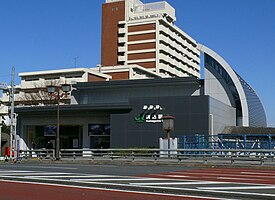Komagome railway station
| Komagome railway station | |
|---|---|
|
North entrance of the JR train station
|
|
| Data | |
| Design | Through station |
| Platform tracks | 4 (2 per company) |
| opening |
|
| location | |
| City / municipality | Toshima |
| prefecture | Tokyo |
| Country | Japan |
| Coordinates | 35 ° 44 '12 " N , 139 ° 44' 49" E |
| Railway lines | |
|
|
|
| List of train stations in Japan | |
The Komagome Station ( Jap. 駒込駅 , Komagome-eki ) is located in Toshima in Tokyo . It is served by the Yamanote Line of the JR Higashi-Nihon (JR East) as well as the Namboku Line of the Tokyo Metro . The station is numbered N-14 on the Tokyo Metro route map .
history
The station was opened on November 15, 1910 by the Japanese National Railways (now the East Japan Railway Company ) as a passenger station on the Yamanote Line. On April 13, 1945, the station burned down completely as a result of a fire caused by an air raid by the US Air Force . On November 29, 1991, the Namboku Line metro station opened. On December 23, 2006, extensive renovation work, which also included measures for barrier-free equipment with escalators and elevators, was officially completed.
Type of construction and tracks
Both the JR East station and the Tokyo Metro station are built as through stations in the most common train station design . The tracks of the Yamanote Line run at the station in an east-west direction and approach a single central platform . The tracks of the Namboku line follow the course of the national road 455 in north-south direction and run directly below it. The Namboku line also drives to a single central platform.
JR East platform
| 1 | ▉ Yamanote Line | Tabata • Ueno • Tokyo |
| 2 | ▉ Yamanote Line | Ikebukuro • Shinjuku • Shibuya |
Tokyo Metro platform
| 1 |
|
Tōdaimae (N-12) • Iidabashi (N-10) • Meguro (N-01) |
| 2 |
|
Ōji (N-16) • Akabane-iwabuchi (N-19) |
Lines
The station is served by the JR East on the Yamanote Line and from the Tokyo Metro on the Namboku Line. The colors used in the table below correspond to the color codes of the lines used by the respective company.
|
←
|
Lines |
→
|
||
|---|---|---|---|---|
| Sugamo |
JR East |
Tabata | ||
| Hon-Komagome (N-13) |
Tokyo Metro |
Nishigahara (N-15) | ||
Station melody
Since the cherry blossom season in 2006, a track called Sakura Sakura ( さ く ら さ く ら , Sakura Sakura , English cherry blossom, cherry blossom ) has been played because it is assumed that the Yoshino cherry ( 染 井 吉野 , Somei-yoshino , nomenclature Prunus × yedoensis ) could have one of its origins near today's train station. Originally the use of the melody was limited to the cherry blossom season, but from 2007 the melody was used permanently as a station melody.
Surroundings
In the direction of Tabata station, about 350 m from Komagome station is one of only two level crossings on the entire Yamanote line.
The Rikugien Garden ( 六 義 園 , Rikugien ) and the Akutagawa Confectionery headquarters ( 芥 川 製 菓 ) are located near the train station .
use
In 2014, the Yamanote line at the station was used by an average of 47,231 passengers a day, making it 97th out of over 900 on the list of the most frequently used stations on the JR East in 2014. The station on the Namboku line was used by an average of 37,443 passengers per day in 2014, making it 92nd of the most frequently used stations on the Tokyo Metro in 2014.
Footnotes and individual references
- ↑ Passengers boarding in Komagome. Calculation from sold single, collective and monthly tickets.
- ↑ http://www.jreast.co.jp/habenger/index.html Source: JR East, rank 97
- ↑ http://www.tokyometro.jp/corporate/enterprise/zügeger_rail/transportation/züge/index.html Source: Tokyo Metro, rank 92
